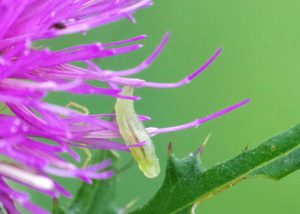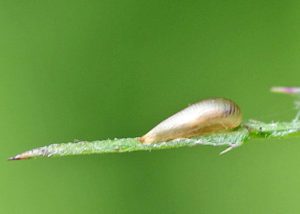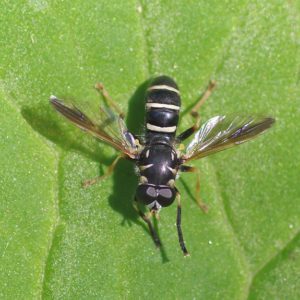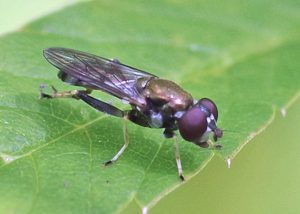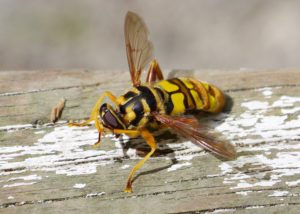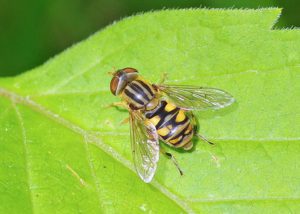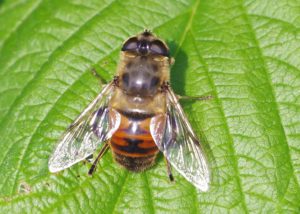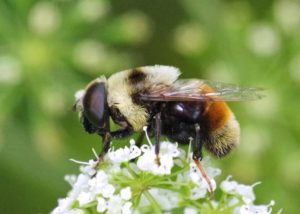Howdy BugFans,
It’s no secret that the BugLady is enthralled by syrphid/hover/flower flies (family Syrphidae), those often-exquisitely-decorated little flies https://bugguide.net/node/view/407691/bgpage that mimic a variety of wasps and bees and are featured in so many of her “Summer Survey” episodes. This summer she photographed several different “flavors” of syrphids, and so she’s sticking her toe into the shallow end of syrphid fly identification. There are 6,000 species of syrphid flies worldwide –including 813 in North America, with more than 150 species around the Great Lakes alone, so she’s got her work cut out for her.
Despite their resemblance to insects with stingers, syrphids are innocent. It’s called Batesian mimicry – something that’s harmless protects itself by resembling something that’s not. It’s easy to tell the difference when they’re at rest – they don’t have stingers (a female’s tapered abdomen may make it look like she does https://bugguide.net/node/view/138871/bgimage), and where wasps and bees have four wings, flies only have two. You can often see that a syrphid’s abdomen looks “deflated” https://bugguide.net/node/view/580219/bgimage. Syrphid flies range in size from ¼” to the size of a small bumble bee.
Adults of many species feed on nectar and pollen that they sponge up with tubular mouthparts. They’re good little pollinators (especially the hairier species), although most feed randomly on white or yellow flowers (unlike bumble bees, which target flowers of a particular species on each outing – flower constancy – ensuring that pollen gets delivered to the right place).
Their larvae (maggots) live a variety of lifestyles; some are decomposers, eating decaying organic bits or wet wood; some eat living plant material like ornamental flower bulbs (and are unwelcome in greenhouses), and others, although eyeless and with only rudimentary legs, prey on small invertebrates like aphids https://bugguide.net/node/view/1386581/bgimage. The aquatic larvae of some species feed on tiny organisms and organic detritus in shallow waters and are called rat-tailed maggots (https://bugguide.net/node/view/166995/bgpage – the “tail” is a breathing tube), and a few live in ant or bumble bee nests. The BugLady wonders if the syrphid larva in her picture escaped the lurking crab spider.
Adults find each other by sight and probably by sound – they can make a soft “hum” by vibrating some structures in their thorax that are independent of flight. The BugLady couldn’t find anything about courtship https://bugguide.net/node/view/697135/bgimage, but females of carnivorous species lay eggs on vegetation near aphid colonies, and when the larvae hatch, they go to work. After two or three weeks and around 400 aphids, the larvae are ready to form a pupal case inside of their hardened final larval skin (puparium) (looks like a slipper shell), and there they overwinter.
These are Fair-weather Flies – if you see one, it’s probably warm and sunny. Most are also home-bodies, seldom leaving the area where they hatched.
The BugLady found an amazing paper about syrphid fly migration. It’s a known phenomenon among some European species, and it had been recorded on the East Coast of North America nearly 100 years ago, but it had not been noted in the literature since then. In the paper, researchers Menz, Brown, and Wotton discuss a migratory event that occurred in California in 2017 in which it was estimated that hundreds of thousands of syrphid flies passed over a 200 meter-long stretch of trail in 30 minutes.
Here are some of the syrphid flies that the BugLady saw this summer (for most, she’s resisting going out on her usual taxonomic limb and guessing their species). Check them out – they’re all different!
TEMNOSTOMA adds a behavioral component to its deception – it extends its dark, front legs to look like antennae https://uwm.edu/field-station/wasp-mimics-family-syrphidae/. There are eight species in the genus in North America.
NEOASCIA, bronze and lustrous, has aquatic larvae, so adults are found around wetlands. There are only seven species in the area, and they’ve been blessed with great names like Black-margined fen fly, Black-kneed fen fly, Spotted fen fly, etc.
MILESIA – The BugLady went out her back door one day and found this big (3/4”) beautiful Virginia flower fly (Milesia virginiensis) sitting on the stoop. There are only three species in this genus in the area; they’re dynamite wasp mimics, and they have a buzzy flight sound that contributes to the illusion (one common name is Yellowjacket hover fly). The Southern yellowjacket is their doppelganger https://bugguide.net/node/view/1641780/bgimage, and a Southern nickname for these syrphids is the “News bee,” because of their habit of hovering in front of people as if conversing. Here’s more information about this lovely fly: http://bugeric.blogspot.com/2013/08/the-news-bee.html.
HELOPHILUS flies have vertical stripes on their thorax and horizontal stripes on their abdomens (if you’re peeking over their shoulders). Bugguide.net tells us that Helophilus means “marsh lover.” There are nine species in the genus in North America, and a number are restricted to the very far north. Eggs are laid on leaves above a pond, and the larvae drop into the water after hatching, where they feed on submerged, dead leaves.
ERISTALIS – She found two pretty different-looking members of the genus Eristalis – one native and one not. According to bugguide.net, members of this genus are called Drone flies, though some reserve that name for Eristalis tenex. There are 20 species in the genus in North America (several are non-native), and many are on the larger end of the syrphid fly size continuum. According to bugguide.net, the genus name comes from the “Latin eristalis, a kind of gemstone, maybe opal.”
Eristalis tenax (the Drone fly) is non-native; it’s Eurasian in origin but has been here at least since the Civil War and is now found over most of the continent. You may have to look twice (or thrice) to tell it’s not a honeybee, partly because of the color and partly because of behavior – this hover fly doesn’t hover, it flies like a bee. Like the bees that they resemble, Drone flies can trap pollen grains in the hairs on their bodies and use their legs move the pollen to special bristles on their front and rear legs. Unlike the bees they resemble, Drone flies eat the pollen off of their legs instead of bringing it home for a brood.
Eristalis flavipes gave the BugLady quite a start one day in the Bog when she realized that the “bumble bee” that she was chasing had a big rusty patch on its abdomen (https://uwm.edu/field-station/rusty-patched-bumble-bee/), but as soon as she looked at its tiny, round antennae and its big eyes, she knew it was a fly. Not all individuals have the rusty patch. Flavipes means “yellow-footed” so let’s call it the Yellow-footed flower fly. The Yellow-footed flower fly fooled the BugLady because it forages like a bee rather than a fly, and because it has even adopted the bumble bee’s tone of voice. It’s found in the northern two-thirds of North America.
See – they DO look different! We can do this!
The BugLady

